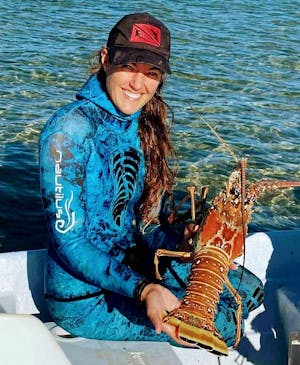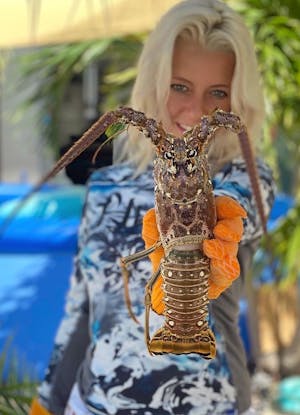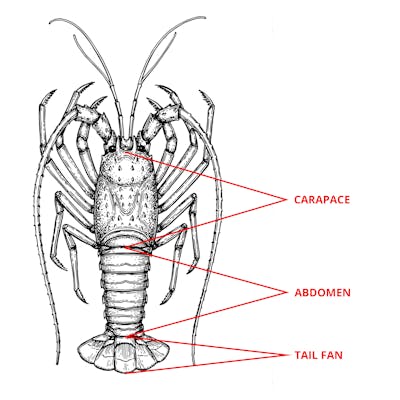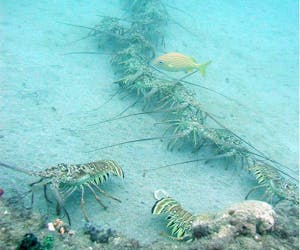Free Shipping on orders of $49+ | Signup for Direct Rewards
Free Shipping on orders of $49+ | Free Store Pickup | Signup for Direct Rewards
Free Shipping on orders of $49+ | Signup for Direct Rewards
Free Shipping on orders of $49+ | Free Store Pickup | Signup for Direct Rewards

Have you caught the bug? The Florida Spiny Lobster bug that is. Every year, Lobster Mini Season falls on the last consecutive Wednesday and Thursday of July. During the weeks prior, people start getting their gear ready and start scoping out prime spots for lobstering. They realize Florida Spiny Lobster Season is only a few weeks away and they want to be ready. I mean, what’s better than the thrill of the hunt? And how satisfying is it to cook up your day’s catch for dinner?
If you’ve never been bitten by the lobstering bug, one trip down is all it takes. Before you hit the docks, you’ll be planning future dives and hopping in the water as often as possible to hunt the bugs during season.
A favorite food of many (divers and non-divers alike), the Florida Spiny Lobster can be cooked up and served in many ways. Also referred to as the Caribbean Spiny Lobster, this species makes its home in the reefs and rocks of the tropical and subtropical waters of the Atlantic Ocean, Caribbean, and Gulf of Mexico. These lobster don’t have claws but do have spines all along their body and antennae to protect them from predators–hence the name, Spiny Lobster.
This year, Lobster Mini Season is July 30-31, 2025. Regular Lobster Season officially opens August 6, 2025 and runs through March 31, 2026. Why isn’t the spiny lobster season all year long? Well, they spawn March through August. So if we want to keep eating lobster year after year, we gotta let them do what they do and make more.
Always check the Florida Fish and Wildlife Conservation Commission site for rules and updates before heading out to hunt.
FWC Officer Bobby Dube runs through the basics on lobstering in Florida at our Divers Direct Key Largo store.
FWC Officer Bobby Dube runs through the basics on lobstering in Florida at our Divers Direct Key Largo store

While most everyone guards the secret of their favorite lobstering spot very closely, a good place to start is the nooks and crannies of the reefs. You can find lobster in as shallow as 3 feet of water and as deep as 100+ feet. If you get out on a wreck, be sure to safely check all the tiny, dark spaces as the lobster will retreat and hide there.
To be honest, just about everywhere along the Florida coast (east, west, and panhandle) is a good place to go lobstering. And absolutely every reef is going to have lobster hanging out. The reefs and wrecks that are further out or aren’t as popular will likely have more lobster in and around them.
We often get asked if it’s better to go out on a dive boat or to shore dive for lobster. The answer is - it depends on the dive boat crew and how many people are going lobstering. Some dive boats have divemasters who are quite proficient at lobstering and will do their best to help you go home with your bag limit. But if you hit a reef with 10 other people also out looking for lobster...you may or may not find your bag limit that day.
Shore diving and diving off a private boat, you’re in control. If you’re not finding lobster in one spot, you can relocate to another spot pretty easily. Though many like to hop on a boat and head out a bit, don’t knock shore diving. Many...and we mean MANY people bag their limit daily when shore diving.
Wherever your lobstering adventures take you, just make certain you’re not in a ‘no take’ area.
A true seasoned minimalist freediver will be able to swoop down, grab one with their bare hands, measure it, and bring it up to add to the catch bag or cooler. If you’re one of those...we all want to go lobstering with you!
For the rest of us, it’s time to grab your gear and hone your skills.
First, never, never, never, never, never (did we say NEVER?) use a spear of any type or anything that will crush or penetrate the exoskeleton when lobstering.
Now that we got that no-no out of the way, let’s get on with it. Spotting the lobster is a talent. You have to get close to the rocks and reefs to look in all the nooks and crannies - that’s where they hide. As a responsible diver, this is where refining your skills comes into play. You want to hunt and take home lobster without harming the reefs and aquatic environments. It’s a balance and it’s easily achievable with a little effort.
Many find it easier to hunt these crustaceans at night. This is because these creatures are more active at night and more likely to come out of their hiding spots. And even when they’re hiding at night, when you shine your dive light you’re gonna see their eyes glow. If you shine your light in a slow, smooth, sweeping motion, you’re less likely to scare them back into their hiding spot.
Once spotted, decide if you’re going to try and free-hand it, use the snare, or go with the tickle stick and net. No matter which method you use, you get one shot. If it gets away from you, you will likely chase it to its next hiding place and try again. Although, they’re fast so unless you’re equally quick or have a good spotter, they might be gone, baby, gone.

Freehanding - you want to grab the spiny lobster by the head or carapace. If you try to grab it by the tail with your hand, it will likely slip away. Additionally, until you check for roe, you don’t want to risk causing harm or trauma to that area.
Snare - you want to slip the snare over the tail gently. Works best if you set the snare behind them and use the tickle stick to gently guide them back into the snare. Make sure the snare is up close to the carapace, well over the abdomen (or tail), before pulling it tight. They will wriggle and try to get free and if you’ve only got it over the end of the tail (in the tailfan area), you’ll likely be chasing them to their next hiding spot and trying again.
Tickle stick and net - this tried and true method is usually best done with a partner. One person on the tickle stick, the other on the net at the ready. Know that when you touch them with the tickle stick, they are gonna go the opposite direction. This usually means further back into the hole, unless you do it right. You often want to find the hole on the other side of their hiding spot and position your net there. Target the absolute smallest possible exit. These lobster will fold down and take off through the smallest crack or crevice possible to get away from you.
Once they’re in the net, you’re not done. You gotta wrap your hand around the net opening and keep them in there until you can get a hand on the lobster. Note that though it’s a pain in the butt for us to pull them out of the net...they somehow can slip right out.
Whichever method you’re using, make sure you check for roe and measure the lobster before putting them in your catch bag. It’s ok to double check once you get back to the boat, but make sure you do both of these before you head off to catch the next one. We all love eating lobster, so if we want to ensure there’s more to catch next time, we gotta put back the ones with roe and the ones that are too small.


If you get lucky enough to come upon a lobster walk, it’s easy pickins. Anyone can grab them freehand when they’re on a walk - you might even get two or three in one swoop. Just make sure you measure and check each for roe before bagging them.
Keep in mind that everyone has different skills and talents. Some are really good at spotting the lobster, some are good at snagging them with their gloved hands, while others are really good with the snare or net and tickle stick. Whereas it can be fun to compete with your fellow divers, sometimes it’s more beneficial to team up and work together. I mean, we all want to come up and go home with your bag limit every time. And your skillset might compliment another diver’s.
Cleaning your catch is super easy. Once you get back to the dock and lay your catch out on the cleaning table, grab your filet knife and slice just behind the head (or carapace), right along that first band. Break off those spiny antennae and hang on to them - you’re gonna use them shortly.
Once all the heads are removed, grab a pair of wire cutters and snip off all those spines on the back of the tail. Now you’re ready to use the antennae. Pick up an antennae, holding the larger end. Grab a lobster tail and turn it over. Slip that antennae in right about where the tail ‘fins’ meet in the middle, twist, and pull back towards yourself. Voila. A slimy grey ‘string’ should be attached to the antennae. You just removed the entrails in one quick, easy movement. Now your lobster tail is ready to rinse off, take home, and cook up.
After you’ve cleaned your lobster tails, rinse them in freshwater. Put your lobster tails in a molded plastic container and fill with fresh water. Then pop that container in the freezer until you’re ready. When you thaw them to cook, your lobster tails will taste just as fresh as the day you caught them.

Now that you know how to catch them, where to catch them, and when to catch them, all you need is gear. Regardless of everything else, make certain you have a Lobster Gauge on you any time you’re diving for Florida Spiny Lobster. It is, after all, the law. While we’re on this topic, make sure you have an up-to-date Florida Fishing and Lobstering License and ALWAYS take your Dive Flag.
To get around easier down there, you’ll appreciate a pair of Fins. So you can breathe (on the surface) and see (underwater), you’ll need a Snorkel and Mask. Gloves protect your hands from the spines of these crustaceans and you’ll want something to bring your catch home in, so a Lobster Catch Bag or Collection Bag is rather handy to have along.
Other items to consider taking include a Tickle Stick, Net, and Snare. Or, pick up a Deluxe Lobster Kit which includes your bag, tickle stick, net, gloves, and lobster gauge. Then you can fill in any additional gear needs from the list above.
Ready to go catch some bugs?
You are required to measure the Spiny Lobster carapace while in the water, before you put them in your catch bag. The carapace is measured from between the rostral horns (between the eyes) down the middle of the lobster to the rear edge of the carapace. Please check the FWC website for examples and up-to-date regulations.
Flip the lobster over so you’re looking at its underside. Gently lift the pleopods (aka swimmerettes). You’ll immediately know if you’re looking at roe (eggs) or not. Please check the FWC website for examples and up-to-date regulations.
The Florida Spiny Lobster is usually 6 to 10 inches long; however, they can grow to upwards of 2 feet.
Their spines are sharp; however, with the use of gloves you will avoid the painful pokes from their body and antennae.
If there’s a hole or tall seagrass, there’s usually a lobster or three. These crustaceans make reefs, sand flats, and seagrass beds their home. And they know all the best places to hide.
These scavengers forage for small snails and crabs, decaying organic matter, and some plants. However, they will eat most anything they can find.